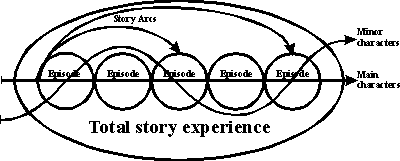
Like Freytag's Pyramid, the Odysseyan Structure can be elaborated upon, particularly for longer works. Audiences are actually quite familiar with the Odysseyan Structure, but in the form of serial works such as television shows, comic books or certain sets of novels (usually trilogies). The Serial Structure can be depicted in this way:

Serial stories are set within a particular world, within a particular mutable situation, which may be made up of many inter-related parts. They have a distinct beginning, middle and end, but it may take several years to traverse the full length of the story. Not all serials are serial stories. Each episode must be a complete story in its own right whether it is Iliadic or Odysseyan in climax structure, but it will contain story threads that cannot be resolved in that single episode, and therefore draw the audience on to the next episode, in order to experience their further development or resolution. Story arcs within the complete series will also have their own beginning, middle and end and their own climax structure. Under these circumstances the audience can be open to individual stories/episodes which are primarily character studies, since it helps to explain the complexity of the plot and enriches their experience of it.
An ambitious example of the Serial Structure would be the television series Babylon 5.
JMS' main criteria for a good science fiction television series include that it must be good science fiction and good television... And to make it a series, it should not be just individual stories (alien attack/ possession/ misunderstanding of the week) -- the stories should be part of an overall larger story, but still watchable each week as a separate chapter.
In keeping with those ideals, a five year storyline (the "arc") has been planned as if the show were a five year miniseries. Events have been planned for each season, which will tell a larger story over time. There is plenty of room for individual stories within each season and each episode can stand alone, though certain episodes (which JMS calls "WHAM" episodes) are pivotal to the big picture...
The point of the entire exercise (is) to tell a story. To create a novel for TV that would span five years, for which the pilot is the opening chapter...That, in broad brush strokes, is a little of what I plan to do with the series. It is, as stated, a novel for television, with a definite beginning, middle and end.
Creating stories of this nature on the Web, or in the future for interactive TV, generates all sorts of ancilliary benefits. After a few episodes, if the story is interesting enough, people will be keen to access the next episode as soon as it is made available. However, from word of mouth people may join the story after it has already been in progress, in which case they may access an archive of previously released stories.
Currently, this is not possible for television, but is managed by a network of fans who exchange video tapes of their favourite shows. In order to create a seamless imaginary world, the story need not make a point of its unique elements, such as its technology or social situations, and leave that to informational links as was done in Eon 4 [O'B96]. It is also now possible to more fully explore over time, parallel and interconnecting storylines as was done in The Spot [Zak96]. In this fashion no characters need be considered secondary if they are of more interest to the audience than other characters, and yet all characters are still contributing to a bigger picture. Finally, with the advent of bi-visible and bi-followable links (as first described by Ted Nelson [Nel94] and implemented by Hyperwave [Mau92] the audience will be able to more readily interact with the work of professional storytellers by connecting their own commentary and fan fiction to the main story system.
Copyright © 1997 Katherine Phelps